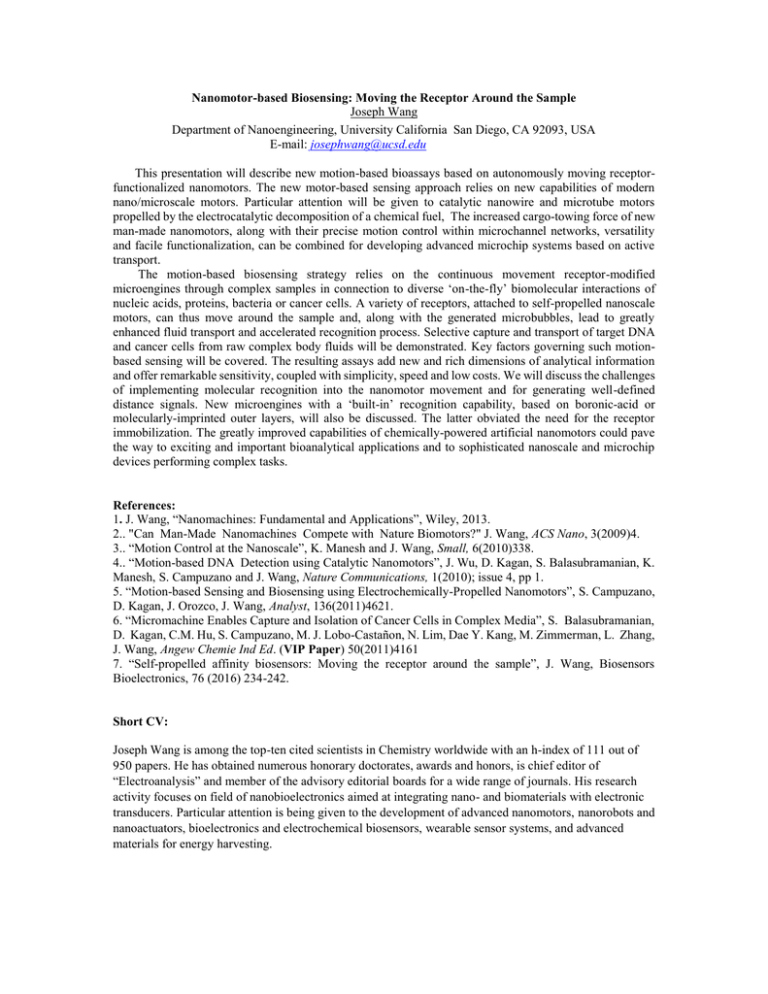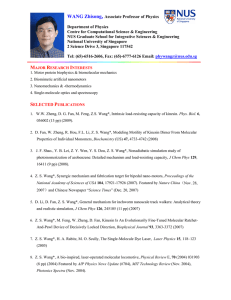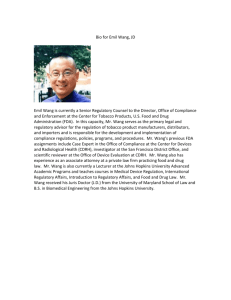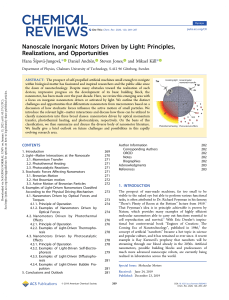Nanomotor-based Biosensing: Moving the Receptor Around the
advertisement

Nanomotor-based Biosensing: Moving the Receptor Around the Sample Joseph Wang Department of Nanoengineering, University California San Diego, CA 92093, USA E-mail: josephwang@ucsd.edu This presentation will describe new motion-based bioassays based on autonomously moving receptorfunctionalized nanomotors. The new motor-based sensing approach relies on new capabilities of modern nano/microscale motors. Particular attention will be given to catalytic nanowire and microtube motors propelled by the electrocatalytic decomposition of a chemical fuel, The increased cargo-towing force of new man-made nanomotors, along with their precise motion control within microchannel networks, versatility and facile functionalization, can be combined for developing advanced microchip systems based on active transport. The motion-based biosensing strategy relies on the continuous movement receptor-modified microengines through complex samples in connection to diverse ‘on-the-fly’ biomolecular interactions of nucleic acids, proteins, bacteria or cancer cells. A variety of receptors, attached to self-propelled nanoscale motors, can thus move around the sample and, along with the generated microbubbles, lead to greatly enhanced fluid transport and accelerated recognition process. Selective capture and transport of target DNA and cancer cells from raw complex body fluids will be demonstrated. Key factors governing such motionbased sensing will be covered. The resulting assays add new and rich dimensions of analytical information and offer remarkable sensitivity, coupled with simplicity, speed and low costs. We will discuss the challenges of implementing molecular recognition into the nanomotor movement and for generating well-defined distance signals. New microengines with a ‘built-in’ recognition capability, based on boronic-acid or molecularly-imprinted outer layers, will also be discussed. The latter obviated the need for the receptor immobilization. The greatly improved capabilities of chemically-powered artificial nanomotors could pave the way to exciting and important bioanalytical applications and to sophisticated nanoscale and microchip devices performing complex tasks. References: 1. J. Wang, “Nanomachines: Fundamental and Applications”, Wiley, 2013. 2.. "Can Man-Made Nanomachines Compete with Nature Biomotors?" J. Wang, ACS Nano, 3(2009)4. 3.. “Motion Control at the Nanoscale”, K. Manesh and J. Wang, Small, 6(2010)338. 4.. “Motion-based DNA Detection using Catalytic Nanomotors”, J. Wu, D. Kagan, S. Balasubramanian, K. Manesh, S. Campuzano and J. Wang, Nature Communications, 1(2010); issue 4, pp 1. 5. “Motion-based Sensing and Biosensing using Electrochemically-Propelled Nanomotors”, S. Campuzano, D. Kagan, J. Orozco, J. Wang, Analyst, 136(2011)4621. 6. “Micromachine Enables Capture and Isolation of Cancer Cells in Complex Media”, S. Balasubramanian, D. Kagan, C.M. Hu, S. Campuzano, M. J. Lobo-Castañon, N. Lim, Dae Y. Kang, M. Zimmerman, L. Zhang, J. Wang, Angew Chemie Ind Ed. (VIP Paper) 50(2011)4161 7. “Self-propelled affinity biosensors: Moving the receptor around the sample”, J. Wang, Biosensors Bioelectronics, 76 (2016) 234-242. Short CV: Joseph Wang is among the top-ten cited scientists in Chemistry worldwide with an h-index of 111 out of 950 papers. He has obtained numerous honorary doctorates, awards and honors, is chief editor of “Electroanalysis” and member of the advisory editorial boards for a wide range of journals. His research activity focuses on field of nanobioelectronics aimed at integrating nano- and biomaterials with electronic transducers. Particular attention is being given to the development of advanced nanomotors, nanorobots and nanoactuators, bioelectronics and electrochemical biosensors, wearable sensor systems, and advanced materials for energy harvesting.




